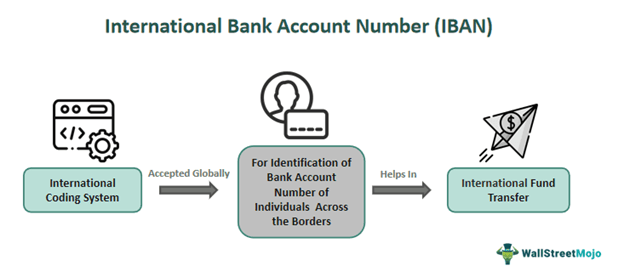Table of Contents
What Is International Bank Account Number (IBAN)?
International Bank Account Number (IBAN) refers to an international coding system accepted globally, helping identify personal bank accounts located in various banks worldwide. Many banks use IBAN to correctly process and transfer money into the correct location, bank, and recipient's bank account. It consists of a 34-digit alpha-numeric code expressing the full details of the account number.

Most European nations and other countries use IBAN to enable money transfers. The Society for Worldwide Interbank Financial Telecommunications (SWIFT) publishes the IBAN registry according to international standards. While USA banks primarily utilize the ABA routing system for domestic money transfers, they rely on SWIFT for international money transfers, not IBAN.
Key Takeaways
- International Bank Account Number (IBAN) is a standard international coding system for identifying foreign bank accounts.
- It helps the sending bank determine the right account bank where it has to deposit funds for the recipient during international money transfers, including a variety of other transfers.
- IBAN is usually in the form of an alphanumeric code consisting of country code, check digit, bank identifier, branch code, and account number.
- IBAN helps locate a single foreign bank account of the recipient, whereas SWIFT helps identify only the sender's international bank details.
- In contrast, the bank account refers to the personal bank account of any individual used for local money transfers.
International Bank Account Number Explained
International Bank Account Number (IBAN) is a system of alphanumeric codes used to recognize the recipient’s account number in another country. It enables financial markets to monitor whether transaction information is genuine or fake regularly. IBAN typically starts with the country code, followed by three to five alphanumeric characters. It consists of a country code, check digit code, bank identifier code, branch code (sort code), and account number.
The Hargreaves Lansdown provides access to a range of investment products and services for UK investors.
The last three codes in the international bank account number format- bank identifier code, branch code (sort code), and account number - collectively form the Basic Bank Account Number (BBAN) used to find and locate a particular bank. These codes are used in international money transfers. Although the USA and Canada do not utilize the IBAN system, they recognize the system for processing payments internationally. These countries process the transfer using the routing code plus the bank account number. IBAN facilitates the identification of the recipient's bank account across borders. Below are some examples of IBAN codes for various countries:
- Luxembourg: LU 28 001 94006447500004
- UK: GB98RBOS16605010796587
- Cyprus: CY 17 002 00128 00000012005276002
- Kuwait: KW81CBKU0000000000001234560101
The Wise Homepage EU offers access to a range of international banking solutions for both individuals and businesses.
Examples
Let us use some examples to understand the topic.
Example #1
Alex wanted to send money from country A to country B. Hence, Alex obtained the following details for remittance.
| Country Code | Check Digits | Bank Identifier | Basic Bank Account Number (BBAN) |
|---|---|---|---|
| GB | 96 | APNBP | 165623 12345678 |
Using these details, Alex can check the international bank account number to ensure accuracy before initiating the money transfer from country A to country B. Alex would be able to send the money to relatives easily.
Example #2
Noah wanted to send money from country 1 to another country 2. Hence, Noah obtained the following details for remittance.
| Country Code | Check Digits | Bank Identifier | Basic Bank Account Number (BBAN) |
|---|---|---|---|
| HB | 76 | AQNBP | 165923 12345678 |
Using these details, Noah can smoothly send money to his relatives.
How To Find?
Usually, the IBAN appears as an alphanumeric code used to find and locate a particular bank. It can be obtained through various methods, including using an online IBAN generator. Alternatively, individuals can locate the IBAN from the bank statement, the bank's website, or the bank's customer website portal. Some banks offer IBAN information via internet banking services or mobile banking apps. Additionally, international organizations like SWIFT may provide tools or resources to assist in locating IBANs for particular banks or nations.
IBAN Vs. SWIFT Code Vs. Account Number
Using the table below, let us look at the difference between IBAN, SWIFT Code, and account number.
| IBAN | SWIFT Code | Account Number |
|---|---|---|
| It helps identify a person's particular bank account in another country. | It helps identify the bank of the international recipient. | It is the private bank account number of an individual. |
| It is created in the standard international numeric system format to determine the overseas bank. | It is shorter in length. | Depending on the bank's requirements, it may or may not be long or short. |
| Only a few countries have adopted the IBAN. | It is a widely and most accepted format for international money transfers. | It is widely accepted across the nation for money transfers. |
| It contains up to 34 characters. | It contains up to 11 characters. | It varies in the number of digits. |
| It contains complete details of an account number of a foreign country. | It does not contain complete information. | It only signifies the bank account number. |
Disclosure: This article contains affiliate links. If you sign up through these links, we may earn a small commission at no extra cost to you.

